The agenda for the meeting last night, April 6, was to publish a survey to the residents and customers of the Green Mountain Water and Sanitation District (Green Mountain) sharing settlement options with the residents and customers. At some point soon the elected board members will decide what kind of settlement offer, if any, to make to the plaintff Rooney Valley developers. The board members would like to know what their constituents think.
The meeting quickly devolved into a discussion of the merits of inclusion. Director Hanagan and Board counsel Timmons have made their decision (although counsel does not have a vote). A new IGA with the Rooney Valley developers. They are working very hard to sell it to the other board members and the public.
If the board decides to provide sewer service outside the district boundary, there are two options.
1. Inclusion – bringing the new Rooney Valley developments into the district – like annexation.
2. Intergovernmental agreement – keeping the Rooney Valley developments outside the boundary but providing sewer service over the boundary.
There are pros and cons both ways for both options. An IGA may be the best option. But we didn’t hear the pros and cons last night. What we heard was a drumbeat of misleading misinformation about inclusion in order to sell the IGA option as the only option.
Director Hanagan stated in no uncertain terms that, even before a public hearing and discussion with the other board members, she will not consider inclusion.
Counsel Timmons provided numerous amendments to the survey piece to virtually eliminate inclusion as an option.
Why. It appears that the plaintiffs only want to consider an IGA. Why.
Because if its an IGA, the Rooney Valley developers control the distribution of sewer service in Rooney Valley – they run the system until they cash out. Then the typically unaware new residents realize they just inherited a sanitation system.
If it’s inclusion, an elected board of citizens and a highly trained professional staff run the system – Green Mountain.
Here are the arguments made last night and why they are terribly misleading.
1. Counsel Timmons insisted that reference to “sewer service” in the survey was misleading. She argued that Green Mountain was not providing sewer service outside its boundary.
The first problem with that brand new definition of what is being proposed is that every document ever prepared, including the Big Sky IGA and the Solterra IGA, all refer to it as “sewer service” or “sanitation service”. Outside the district boundary. I expect Denver Wastewater also calls it “service”. By definition, that is what it is. And the fact remains, Green Mountain is under no obligation to provide that service outside its boundary.
Here is a screen shot of the Big Sky IGA and Solterra IGA referring to the “sewer service”:
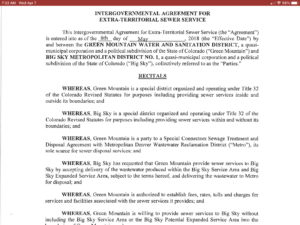
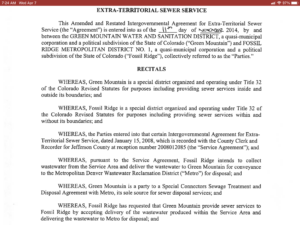
Counsel Timmons, repeating the plaintiffs’ spin on the issue, argued that the only thing happening is hooking up Big Sky’s pipe to Green Mountain’s pipe.
Again, thats not what either the Big Sky or the Solterra IGAs state:
Green Mountain will be responsible for the design of the system. With that comes potential liability for defective designs.
Green Mountain will be responsible for monitoring the construction. With that comes potential liability for negligent oversight.
Green Mountain will enter into a maintenance agreement. Green Mountain will be potentially liable for negligent maintenance.
Green Mountain will be responsible if there is a spill or other major catastrophe.
It is a service and its a lot more than just hooking up a pipe.
And, if, as counsel Timmons argues, nothing is happening outside the boundary of the district, then you don’t need inclusion, or an IGA. The lawsuit should be dismissed because the IGA is moot.
The problem of course is that not only is Green Mountain providing services outside the district boundary, but accepting sewage from outside the district into the Green Mountain system is providing sewer service for stuff that originated in toilets outside the district boundary. Otherwise, why would it be necessary to get approval from Denver Waste.
Here again are some examples from the Solterra IGA that refer to providing sewer service and providing service outside the district boundary.
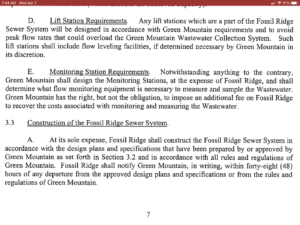
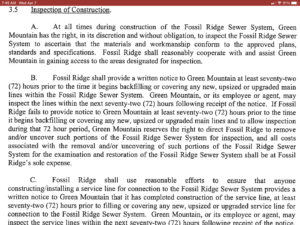
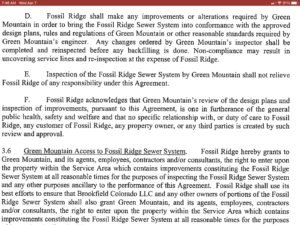
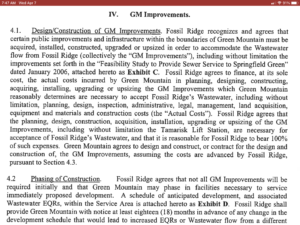
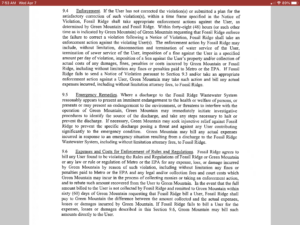
Note that the Solterra IGA and Big Sky IGA charged the new customers 25% more for the “service” than the district residents are paying.
As Director Morgan pointed out, how can we charge the new residents a fee, never mind a fee that is 25% higher than the district’s own residents, if we aren’t providing a “service”.
Good question. Counsel Timmons’ response was something along the lines of “this meeting is taking too long”.
Of course the other question is why is the developer so willing to charge his future residents 25% more – sounds an awful lot like they are “buying” the district’s cooperation in a venture that is inconsistent with the current and future residents’ best interest.
And someone will need to explain to the Solterra residents why they paid Green Mountain $433,801 last year for sewer service and sewer operation fees, and $401,398 the year before and comparable amounts the past 11 years . . . if there is no “service”.
But tread lightly. Solterra’s IGA for sewer service that, according to counsel Timmons, is not really a compensable service . . . expires in two years.
With no IGA to provide the non-existent service, there will be a rush on fancy backyard portopotties. Counsel Timmons might not think it is a service outside the district boundary but the folks in Solterra will likely miss it when its gone.
2. “The plaintiffs don’t want inclusion, so we can’t want it either.” Interesting negotiation strategy. We will make an offer to settle based on what the plaintiff wants, not on what is in the best interest of the district.
The Rooney Valley developers apparently want an IGA based on their terms and millions of dollars in damages. If we follow the negotiation strategy outlined last night, then whatever the plaintiffs propose is what we must accept. We can’t argue for what is in the best interests of the community.
Another approach is to decide what is in the best interest of the district and make that offer. If the offer includes sewer for the Rooney Valley developers, odds are the Rooney Valley developers will take the offer. They want sewer. They prefer it on their terms. But if it has to be on Green Mountain’s terms, my guess is they will ultimately take what they can get – as long as it includes sewer service.
The Rooney Valley developers don’t want inclusion because they won’t have as much control.
Since when do we define what is in the best interest of the district by what gives the Rooney Valley developers the most control.
My guess is that there is a point where the Rooney Valley developers will take the inclusion option if that is the only way they are going to get sewer.
They want sewer. They would prefer to have absolute control. But more than that, they want sewer.
And inclusion is always an option. Here it is, written into the Solterra IGA and Big Sky IGA:
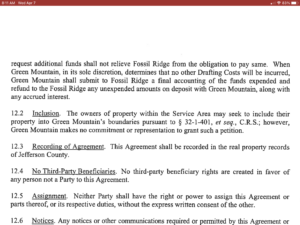
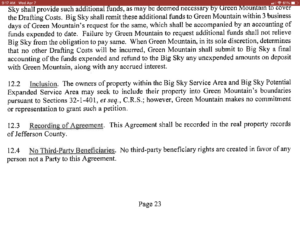
To be sure, Inclusion under Title 32 (google CRS 32-2-401) requires that the landowners of the new area agree to be included. They have a choice. So does Green Mountain. Green Mountain has to agree to accept the new residents into the district.
Need both. The landowners outside the district need to agree to be included. The Green Mountain board must also vote to approve the inclusion.
That is something Green Mountain has to offer the plaintiffs – that Green Mountain will agree to include the new area. That is a settlement option.
In other words, Green Mountain could offer to settle the case by stating to the Rooney Valley developers that, yes, Green Mountain will agree to provide sewer service to their developments but only through the inclusion process.
Just like the IGA – if the Rooney Valley developers want sewer they can agree to do it through an IGA or inclusion- their choice.
If the only option Green Mountain is willing to offer is inclusion and the Rooney Valley developers refuse inclusion, then they don’t get sewer from Green Mountain. Their choice. And Green Mountain’s choice.
3. Inclusion costs the District $25 million. Over and over and over again Counsel Timmons insisted that it was misleading not to include this “fact” in the reference to inclusion in the survey.
Where did that number come from. Apparently some remark made by the District Engineer who has been working for the Rooney Valley developers and District on these issues. But when it was questioned by the directors, Counsel Timmons could not pinpoint the source.
That will continue to be difficult. Because the cost to build the Big Sky (Rooney Valley) Sewer System, for all of Rooney Valley is “only” $3,846,528, not $25 million.
Here is a screen shot of the costs to build the system stated in the Big Sky IGA:
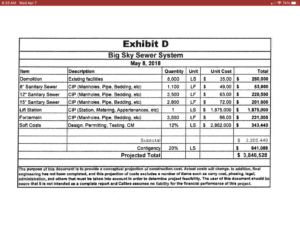
Equally important, Green Mountain will never pay a dime of this cost under either Inclusion or an IGA. That cost will be paid by the Rooney Valley developers first and then repaid by the future residents in either the cost of the developed lot, or two metro district loans (or in most cases both – they will be charged twice for the same cost – another example of metro district abuse).
[Green Mountain will pay the costs of improvements to its system to accommodate the new service – that is true under both the IGA and likely inclusion. Under the Big Sky and Solterra IGA the developer paid the costs up front but Green Mountain “kicked back” fees to reimburse the developer for paying for improvements to Green Mountain’s system.]
Take Solterra for example. Water. They had to get water piped in over 6 miles from Consolidated Water. Cost over $10 million. Consolidated water didn’t pay for it but they now own and maintain the system. Brookfield and now the residents paid for it. Not Consolidated. And in this case, not Green Mountain.
Big Sky and the Rooney Valley developers build the system with supervision from Green Mountain under both inclusion and the IGA.
Big Sky and the Rooney Valley developers pay for it under both inclusion and the IGA.
The cost is passed on to the new residents.
Then, if they use inclusion, the Rooney Valley developers turn it over to Green Mountain just like Solterra turned the water system they built over to Consolidated.
Green Mountain then takes it from there just like Consolidated did for Solterra’s water system.
Another couple Solterra examples. Solterra paid for the dog park and turned it over to the city. Solterra paid for a significant portion of the cost of improvements to Alameda and McIntyre and turned those improvements over to the city.
Now to be sure, under inclusion, Green Mountain will maintain the Rooney Valley Sanitation System. Under inclusion, Green Mountain will own and operate the system doing whatever Big Sky would do (likely not much until things start breaking), maintaining it just as they do Solterra’s system under a maintenance IGA.
That will cost money.
Money that comes from the residents just like the money that comes from the current District residents. Those new residents would pay for the same service as the current residents.
The suggestion that the current residents would somehow pay $25 million for the new system is grossly misleading and simply false.
4. Unstable soils
There was a brief discussion about how Green Mountain really doesn’t want to own the Rooney Valley sewer system because the soils are so unstable there will be a lot of pipes breaking. There was a reference to staff comment about this concern in 2018.
So, it appears the thinking by some board members is, this is unsafe enough that Green Mountain doesn’t want to own it but we are more than happy to charge the future residents who will own it 25% more in fees. And that is somehow in the best interest of the community.
It appears that some members of the Green Mountain Water and Sanitation District are publicly acknowledging that the soils in Rooney Valley present serious challenges (also documented in soil reports going back to 2008) but they are willing to facilitate building a sewer system there as long as they don’t have to be responsible for pipes breaking. And they are still going to charge the future residents 25 % more than their current residents for significantly less service.
It was a late night. Maybe thats not what they meant. But thats what it sounds like.
Counsel Timmons will be preparing an information summary regarding the litigation.
Then there will be a public hearing.
The public hearing is important. It didn’t happen when the first IGA was signed election night May 8.
The new public hearing, even with the stated preference by at least one director for an IGA is not perfect. But with full transparency – as long as the public is aware that at least one director has already made up their mind, it is better than the May 8, 2018, alternative.
Hopefully a majority of the board will keep an open mind as to all the options until after a public hearing on the issues. Maybe an IGA is the best solution. Maybe inclusion. Maybe service from some other source, not Green Mountain. These are all options. There may be other options. Decision will be made soon.
John Henderson
(Disclaimer – This blog is solely my work and does not attempt to represent the position of the Green Mountain Water and Sanitation District or any individual member of the District. The Board was not aware of and did not have an opportunity to review this blog. I have been asked on occasion to provide advice and counsel to the board on a pro/bono basis but this blog, again, is independent of any consulting role I may have provided in the past. All of the information contained in the blog is based upon public information or analysis independent of any consulting role I may have provided to the Board in the past. No information was obtained from the board or obtained in the context of providing service to the board.)
